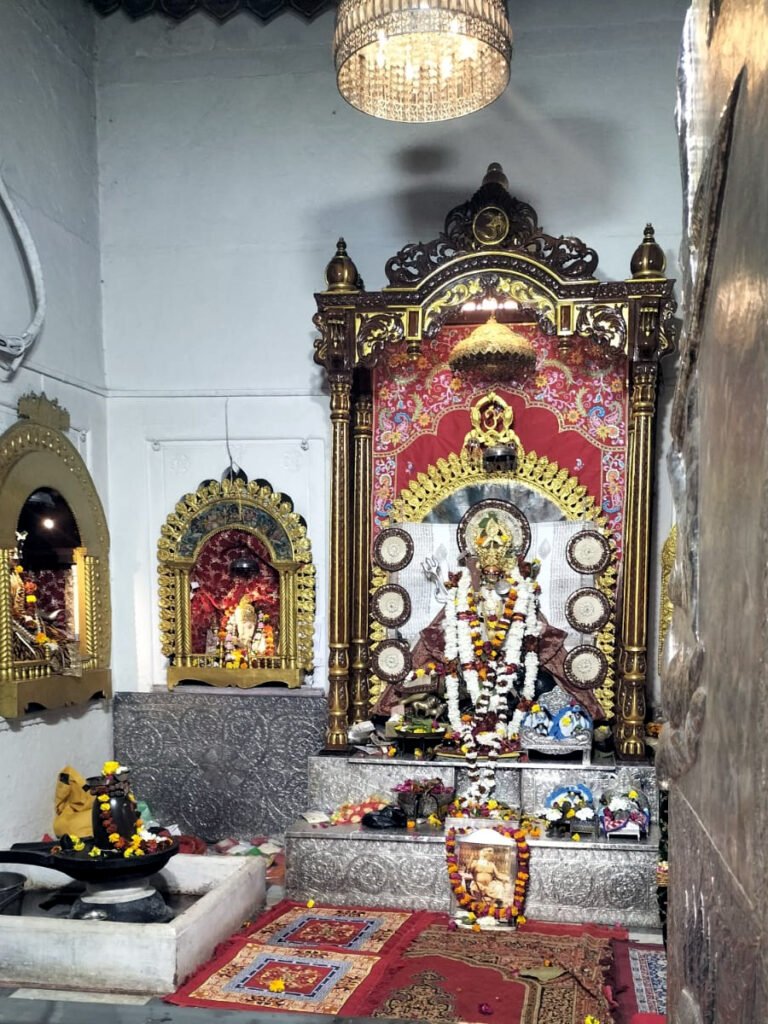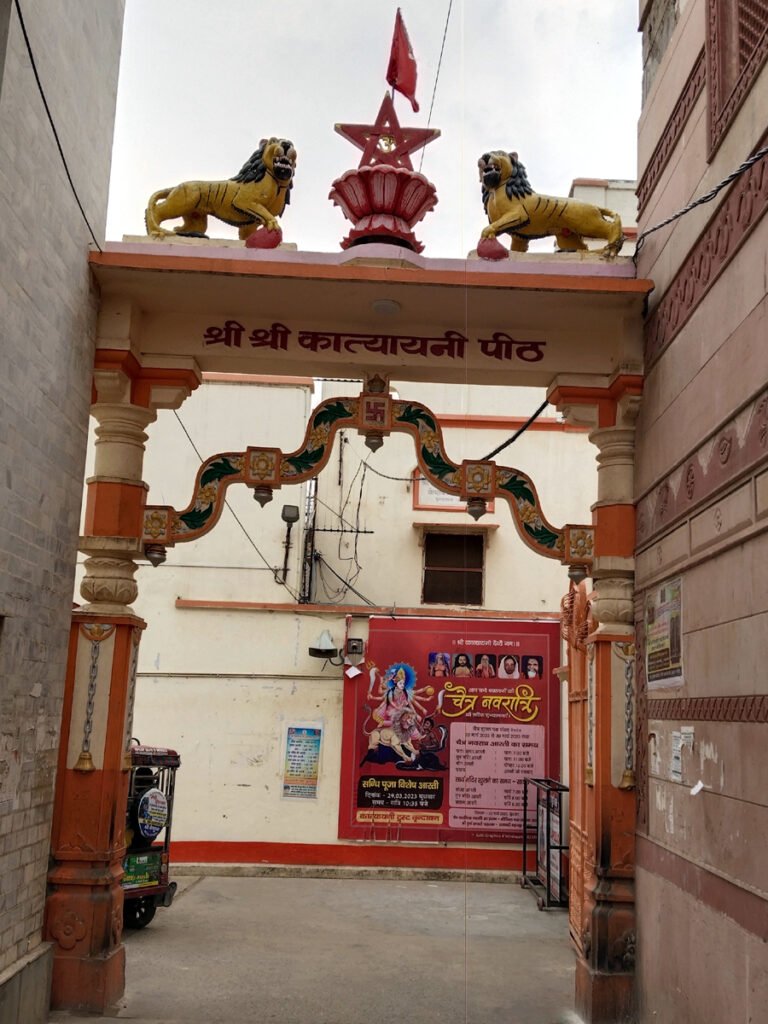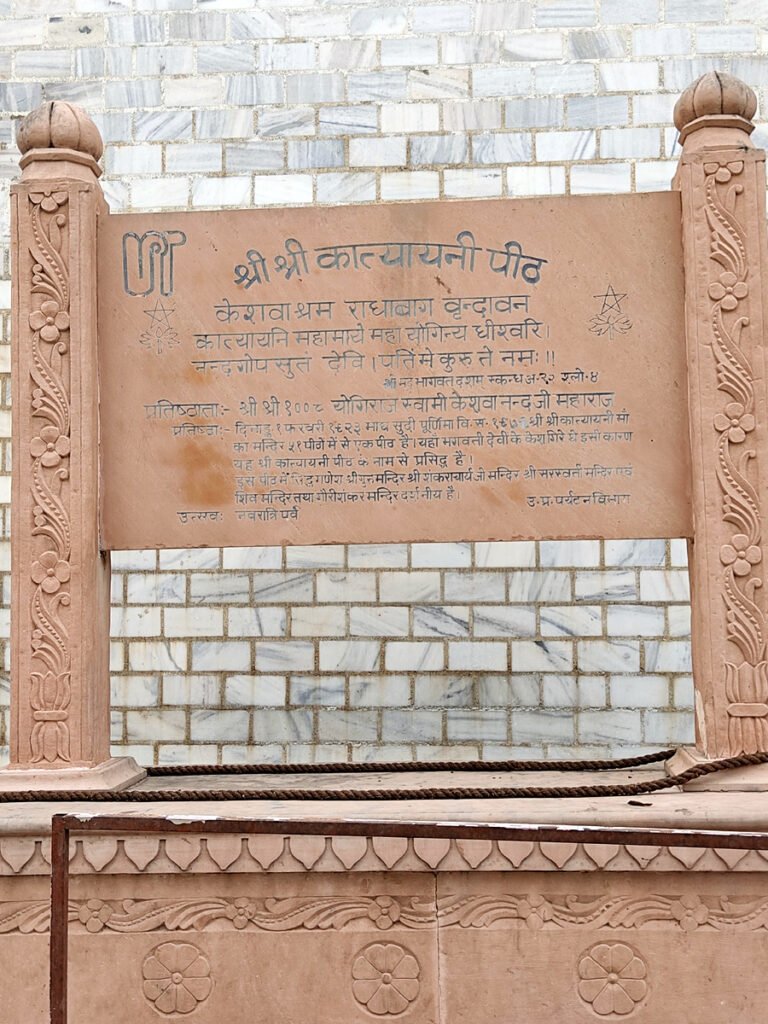Katyayani Shakti Peeth Vrindavan
Katyayani Shakti Peeth also known as Uma Shakti Peeth Vrindavan is a revered Hindu religious site located in Goda Vihar, Vrindavan, Uttar Pradesh, India. 51 Shakti Peeths are places of worship where it is believed that body parts of the goddess Sati fell after she self-immolated and her body was dismembered during the cosmic dance of Lord Shiva, known as the Tandava. Each Shakti Peeth is associated with a specific part of her body.

Katyayani Shakti Peeth in Vrindavan is believed to be associated with the place where the fingers of Goddess Sati are said to have fallen. It’s a significant pilgrimage site for devotees of the Goddess. The temple is dedicated to Goddess Katyayani, who is considered one of the forms of Goddess Durga.
Devotees visit this temple to seek the blessings of Goddess Katyayani, especially during Navratri and other important Hindu festivals. Vrindavan, in general, is a prominent pilgrimage center for followers of Lord Krishna, and the presence of Katyayani Shakti Peeth adds to its religious significance.
Temple architecture is magnificent, it was constructed by Yogiraj Swami Keshvanand Brahmachari in 1923. This temple is supported with huge pillars and built with black stone. We find white marble all over the temple. Apart from Lord Shiva and Goddess Parvati, we have Lord Ganesh, Lord Surya, and Lord Lakshmi Narayan.
This temple is mentioned in the sacred tantric book Rudrayamala, Lakshimidhara, Devi Bhagavatha Purana and Chandimangal. As per the ancient texts, this temple marks the fifth important Shakti Peethas.
Read More >> Arupadai veedu | Six Abodes of Lord Murugan
Contents
- 1 Significances of the Katyayani Shakti Peeth in Vrindavan:
- 2 Places to visit near Katyayani Shakti Peeth Vrindavan:
- 3 FAQ:
- 3.0.1 What is the significance of the Katyayani Shakti Peeth in Vrindavan?
- 3.0.2 What is the history of the Katyayani Shakti Peeth in Vrindavan?
- 3.0.3 How can I get to the Katyayani Shakti Peeth in Vrindavan?
- 3.0.4 What are the opening hours of the Katyayani Shakti Peeth in Vrindavan?
- 3.0.5 What are the dress code and other rules for visiting the Katyayani Shakti Peeth in Vrindavan?
- 3.0.6 What are some of the things to see and do near the Katyayani Shakti Peeth in Vrindavan?
- 3.0.7 What is the significance of the hair of Sati falling at the Katyayani Shakti Peeth?
- 3.0.8 What is the sword of the goddess at the Katyayani Shakti Peeth?
- 3.1 How to reach Katyayani Shakti Peeth Temple:
- 4 Google Maps:
Significances of the Katyayani Shakti Peeth in Vrindavan:
Religious Significance: This temple is believed to be the place where the “Yantra” (a mystical diagram representing the goddess) of the goddess Katyayani fell when her body was dismembered and scattered across different locations during the cosmic dance of Lord Shiva. Shakti Peethas are revered as places of immense spiritual power and divine connection.
Pilgrimage: Devotees visit the Katyayani Shakti Peeth as part of their religious pilgrimage. It is a place of worship, meditation, and seeking blessings from the goddess.
Navratri Festival: The temple becomes particularly vibrant and crowded during the Navratri festival, a nine-night celebration dedicated to the goddess Durga. Katyayani is one of the nine forms of Durga that are worshipped during this festival.
Spiritual Healing and Blessings: Devotees believe that visiting the temple and offering their prayers to Goddess Katyayani can bring them spiritual healing, strength, and blessings for various aspects of life, including love, marriage, and family.
Cultural and Historical Significance: The temple also holds cultural and historical importance as it is part of the rich religious heritage of Vrindavan and India as a whole.
Read More >> Attahas Temple Birbhum Shaktipeeth
According to Hindu mythology, Daksha yagna and Sati self-immolation, it is the holy place
where maa “Ringlets of hair ” fell down. Local people call the deity with the name Uma – “She who has large eyes” and her concert, Bhairava form of Lord Shiva is worshiped with the name Bhotesh.
People believe that Gods have a holy bath at Manikarnika Ghat during 12 P.M. so after their bathwater turns holy. It is believed that the goddess will bless all her devotees who worship with true heart and devotion. We find a goddess sword named Uchawal Chandrahaas, people believe that girls who worship this sword during Navratri will be blessed with the desired bride or groom (Sri Krishna).
After the Navratri festival, during the month of Bhadrapada which comes during the month of August, the third day is celebrated with the festival name “Kajali Tij” during which devotees throng the temple and perform traditional rituals and offerings. Apart from this on every Friday and full moon day, kumkum pooja is offered to Sri Chakra installed by Adi Shankaracharya.
Usually, we find two idols, moola Virat and other is archaka idol in most of the temples, similarly, we have archmurthy for which we perform all kinds of rituals and then enter the temple (Gharbhalaya) to see Swayambhu form of Goddess.
As per the Hindu Scriptures, Srimad Bhagwat Puran, Vrindavan is the place where Lord Krishna used it as a playground during his childhood while cows were grazing. Also, the Gopis of Vrindavan used to worship Goddess Katyayani on the banks of the Yamuna river to get the blessings of the goddess to have Lord Krishna as their consort.

Places to visit near Katyayani Shakti Peeth Vrindavan:
Banke Bihari Temple: This is one of the most famous temples in Vrindavan and is dedicated to Lord Krishna. The temple is known for its unique deity of Lord Krishna, which is not unveiled entirely. It’s a must-visit for Krishna devotees.
Prem Mandir: A beautifully constructed temple dedicated to Lord Krishna and Radha. The temple is known for its intricate marble work and a mesmerizing light and sound show in the evening.
ISKCON Temple: The International Society for Krishna Consciousness has a significant presence in Vrindavan. The ISKCON temple is a peaceful place to visit and learn more about the teachings of Lord Krishna.
Radha Raman Temple: This temple is dedicated to Lord Krishna and is famous for its idol of Radha Raman, a unique and beautiful deity of Krishna. The temple has an interesting history and a serene atmosphere.
Govind Dev Temple: A historical temple dedicated to Lord Krishna. The architecture and intricate carvings in this temple are worth exploring.
Madan Mohan Temple: Another ancient temple dedicated to Lord Krishna. It’s an important religious site in Vrindavan.
Rangaji Temple: This temple is dedicated to Lord Ranganatha, a form of Lord Vishnu. It’s known for its South Indian architectural style, which is quite distinct in the region.
Kusum Sarovar: It’s a historic stepwell surrounded by beautiful gardens. It’s a tranquil place to visit and offers a peaceful environment for reflection.
Nidhivan: A sacred forest believed to be the place where Lord Krishna performed his Raas Leela. It’s considered a highly spiritual and mysterious place.
Gokul: Gokul, the childhood home of Lord Krishna, is a short distance from Vrindavan. You can visit the Gokul Temple and other historic sites associated with Krishna’s early life.
Mathura: Mathura, the birthplace of Lord Krishna, is also nearby. You can explore the Krishna Janmabhoomi Temple, Dwarkadhish Temple, and other historical sites.
Read More >> Shree Kiriteswari Shaktipeeth Temple

FAQ:
What is the significance of the Katyayani Shakti Peeth in Vrindavan?
The Katyayani Shakti Peeth in Vrindavan is one of the 51 Shakti Peethas, which are sacred sites associated with the goddess Shakti. It is dedicated to the goddess Katyayani, who is a manifestation of the goddess Shakti. The temple is located in the town of Vrindavan, which is a major pilgrimage destination for Hindus.
The temple is significant for several reasons. First, it is believed to be the site where the hair of Sati, the wife of Lord Shiva, fell when her body was cut into pieces by Lord Vishnu. Second, the temple is home to a sword of the goddess, called Uchawal Chandrahaas. Third, the temple is a popular pilgrimage destination for Hindus from all over India.
What is the history of the Katyayani Shakti Peeth in Vrindavan?
The exact history of the Katyayani Shakti Peeth in Vrindavan is unknown. However, it is believed to have been built in the 10th century by the Katyuri kings. The temple was later destroyed by the Mughals in the 17th century. It was rebuilt in the 18th century by the Marathas.
How can I get to the Katyayani Shakti Peeth in Vrindavan?
The Katyayani Shakti Peeth is located in the town of Vrindavan, which is about 150 kilometers from the city of Delhi. The temple is easily accessible by road. There are also regular bus and train services from Delhi to Vrindavan.
What are the opening hours of the Katyayani Shakti Peeth in Vrindavan?
The Katyayani Shakti Peeth is open daily from 7 AM to 11 AM and 5.30 PM to 8 PM.
What are the dress code and other rules for visiting the Katyayani Shakti Peeth in Vrindavan?
Devotees are expected to dress modestly when visiting the Katyayani Shakti Peeth. Men should wear full-length pants and shirts, and women should wear long skirts or dresses that cover their knees.
Devotees are also expected to remove their shoes before entering the temple. Smoking and photography are prohibited inside the temple.
What are some of the things to see and do near the Katyayani Shakti Peeth in Vrindavan?
In addition to the Katyayani Shakti Peeth, there are several other places to see and do near Vrindavan. These include:
- The Banke Bihari Temple, which is one of the most popular temples in Vrindavan.
- The Radharaman Temple, which is another popular temple in Vrindavan.
- The Govardhan Hills, which are a sacred pilgrimage site for Hindus.
What is the significance of the hair of Sati falling at the Katyayani Shakti Peeth?
The hair of Sati is believed to be a symbol of her strength and power. It is also believed to be a source of blessings for devotees.
What is the sword of the goddess at the Katyayani Shakti Peeth?
The sword of the goddess is believed to be a symbol of her protection. It is also believed to be a source of strength for devotees.
How to reach Katyayani Shakti Peeth Temple:
Reaching Vrindavan: Vrindavan is a well-known pilgrimage town, and it’s accessible from major cities in North India.
By Air: The nearest airport is the Indira Gandhi International Airport in New Delhi, which is approximately 150 kilometers away from Vrindavan. From the airport, you can hire a taxi or take a bus to Vrindavan.
By Train: Mathura Junction is the nearest railway station to Vrindavan. Mathura is well-connected by trains from various parts of India. From Mathura, you can hire a taxi or take an auto-rickshaw to reach Vrindavan, which is around 12 kilometers away.
By Road: Vrindavan is well-connected by road. You can hire a taxi or take a bus from nearby cities like Agra or Mathura.
Locating Katyayani Shakti Peeth: Once you reach Vrindavan, you can ask locals or use a GPS device to locate the Katyayani Shakti Peeth. The temple is generally not very far from the main Vrindavan area and is easily accessible.
Local Transportation: You can also explore Vrindavan using cycle rickshaws, auto-rickshaws, or rented bicycles.
